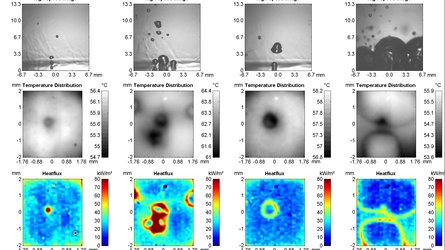
Parabolic flight flow-boiling testing
Thank you for liking
You have already liked this page, you can only like it once!
From soft drinks to hot tubs, people add bubbles to liquids for many different reasons. ESA engineers think bubbles produced at the verge of boiling point could help control the temperature of spacecraft in a more efficient and compact way. The main unknown is how bubbles will behave in differing gravities down to weightlessness, so researchers boarded parabolic flight aircraft for testing.
The International Space Station (ISS), like many other crewed spacecraft, uses liquid circulated through tubes to absorb heat and pass it to external radiators – known as ‘single phase cooling’. But ESA engineers are now looking into a more efficient variation, called ‘two phase cooling’ – already widely employed in terrestrial power plants and petrochemical processes.
It is called ‘two phase’ because it employs two separate phases of matter: liquids and gases. Counter-intuitively, the coolant liquid is heated to the verge of boiling point as it flows through the structure being cooled. Contact with waste heat makes the liquid boil into bubbles of vapour. This ‘flow boiling’ approach can transport heat away much more quickly and efficiently.
With ESA SciSpacE and Airbus Defence and Space support, the Institute of Fluid Mechanics in Toulouse designed a small compact loop for the study of flow boiling in weightlessness, fitting a circuit with a pump, a flow meter, preheaters, a condenser and associated tubing within the strictly limited volume available. A test version has been flown in ESA and CNES parabolic flight campaigns - the former producing bubbly flows in Moon, Mars and terrestrial gravities as well as in microgravity – with the eventual aim of flying it aboard the International Space Station.
-
CREDIT
ESA/Airbus/Institute of Fluid Mechanics -
LICENCE
ESA Standard Licence
-
Closed captions available Captions and subtitles are available (automatically generated by YouTube) - select your language using the YouTube player controls. A non-YouTube version is available using the 'download' button above.
-
Close-up
-
-

Multiscale Boiling

Preparing 'flow boiling heat transfer at low gravity…

Boiling. We research. You benefit.

Preparing boiling experiment for parabolic flight


